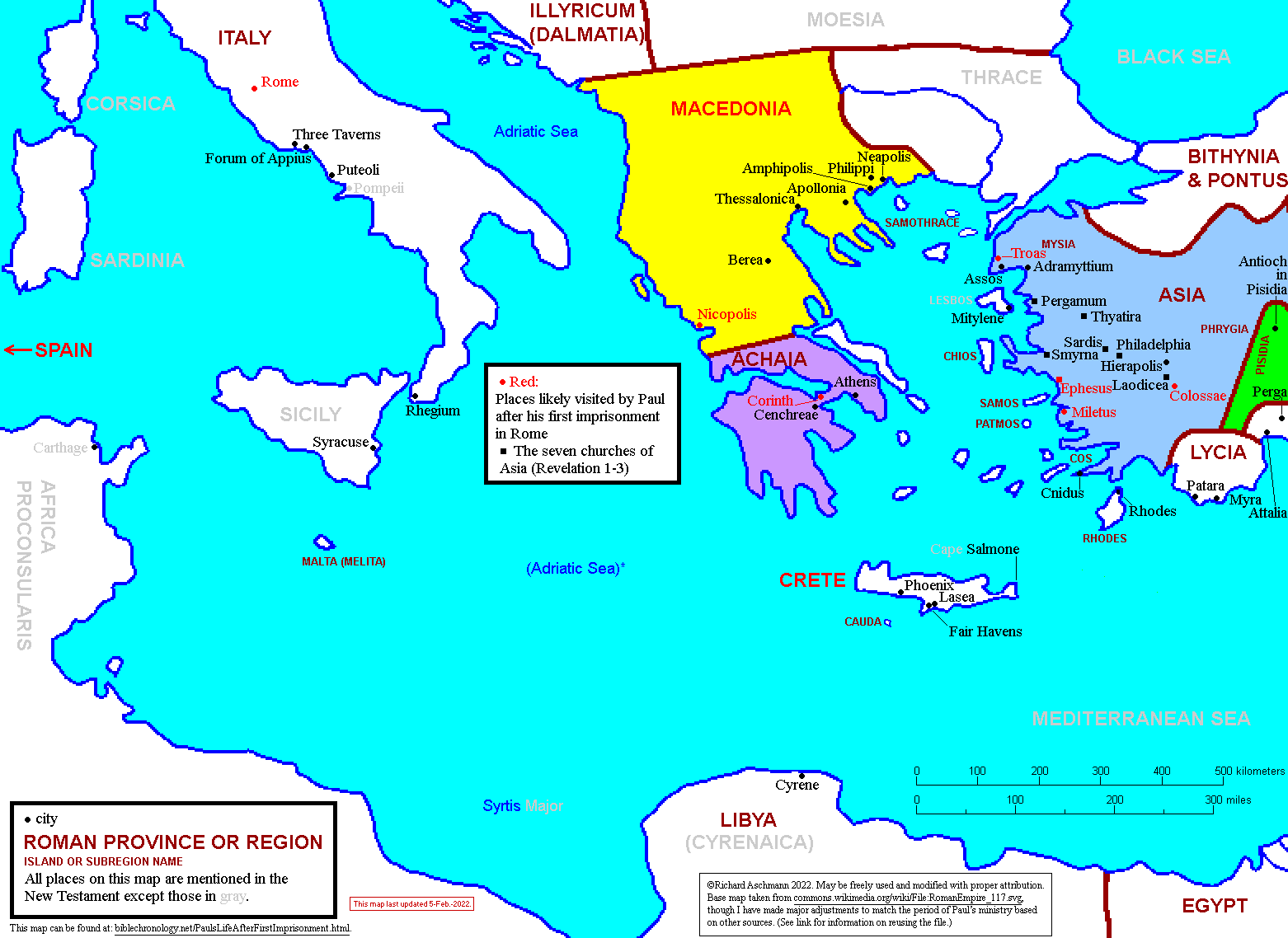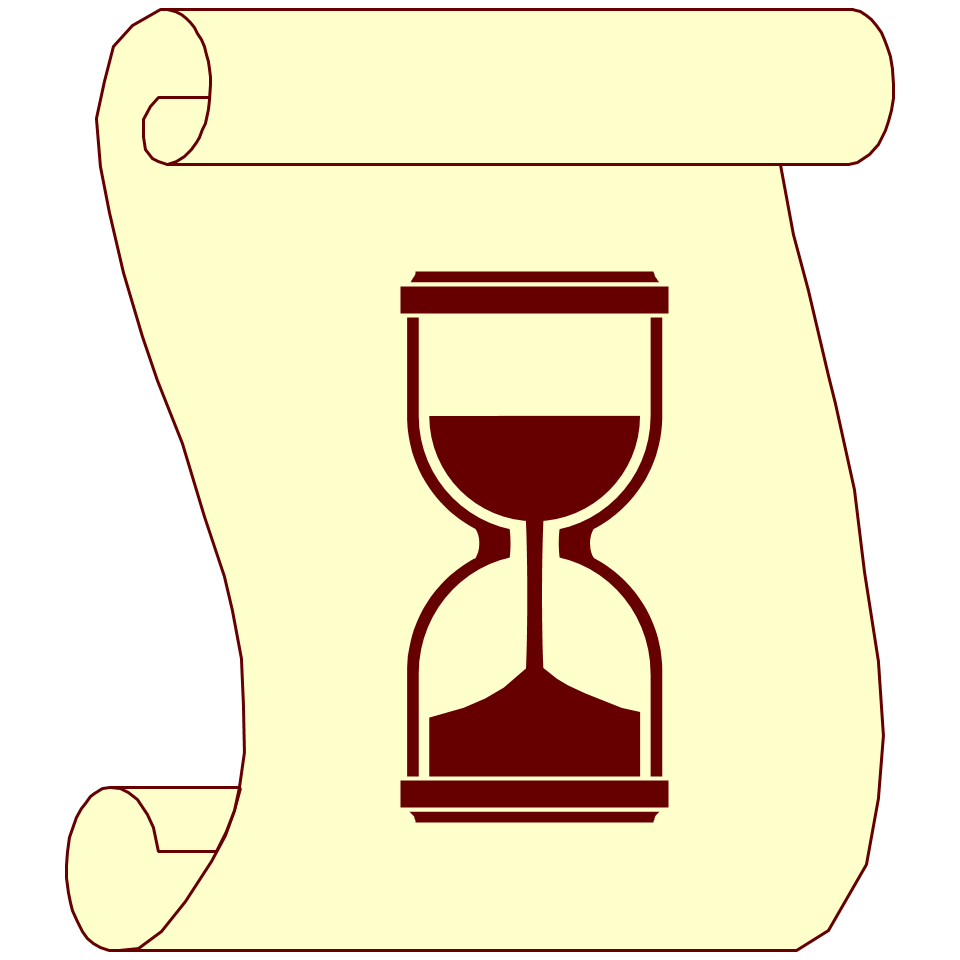|
Paul’s Life After his First Imprisonment |
See map. |
Last updated: 5-Feb-2022 at 17:38 (See History.) © Richard P. Aschmann |
(biblechronology.net/PaulsLifeAfterFirstImprisonment.html)
There is quite a bit of information in the Pastoral Epistles (1 and 2 Timothy and Titus) about Paul’s travels after the end of Acts, when he is evidently acquitted and released. However, how to put this information together in any kind of order is not entirely clear. Two arrangements of the information can be found below.
The only actual disagreement in the order of the events is where the visit to Troas is placed (outlined in red): personally I cannot see why Paul would choose to spend the winter without his cloak; in fact, it seems odd that he would leave his cloak behind anywhere, which leads me to prefer Copeland in this case.
The right column is much more detailed, and the authors carefully explain how each date was arrived at. However, I consider some of their ideas improbable or at least highly speculative, and have marked these in light green. Others of their ideas are more probable, because they represent Paul’s expressed plans in the short term which may well have happened, or represent things that he definitely did which may have occurred in the sequence specified; I have marked all these in olive. Text in black is fairly certain.
I also had initially considered his trip to Spain highly speculative, since, though Paul did indeed plan to go there, that was at least 5 years earlier, and such a trip is never mentioned again in the New Testament. However, I find that a number of early Christian writers believed that he did indeed reach Spain, including Clement of Rome[1], writing to the Corinthians at the end of the first century, which makes Coneybeare and Howson consider it probable, and I tentatively agree with them.
In fact, much of their chronology (except for their theory about the early visit to Troas and the later arrest in Rome) makes sense, though some of the dates must be considered speculative.
|
|
Timeline based
on Mark
Copeland, with additions of my own in
purple |
|
Timeline based
on Coneybeare and Howson,
specifically pages 897 and 894, plus information from chapter
XXVII starting on page 799 |
|
|
|
|
|
|
63 |
Paul is evidently acquitted and released. (Acts 28:30) |
63 |
Paul is evidently acquitted and released. (Acts 28:30) |
|
|
— |
|
He goes to Macedonia (Php.
2:24) and Asia Minor (Colossae, Phm. 22) |
|
|
— |
64? |
He goes to Spain (see page 801; Rom. 15:24-28 indicates this was Paul’s desire at least since early 58.) |
|
|
He evidently visits Ephesus, leaving Timothy there as pastor. (1 Tim. 1:3) |
66 |
Summer: From Spain (?) to Asia Minor (Ephesus, leaving Timothy there as pastor) (1 Tim. 1:3) |
|
|
He visits Macedonia and writes 1 Timothy from there. (1 Tim. 1:3) |
67 |
Summer: He visits Macedonia and writes 1 Timothy from there. (1 Tim. 1:3) |
|
|
He plans to return to Ephesus soon, but realizes that he may be delayed. (1 Tim. 3:14) |
|
He plans to return to Ephesus soon, but realizes that he may be delayed. (1 Tim. 3:14) |
|
|
|
|
He passes through Troas,
and leaves his cloak, books, and parchments there with Carpus. (2 Tim. 4:13) |
|
|
— |
|
He reaches Ephesus as
intended. (1 Tim. 3:14) |
|
|
He visits Crete and leaves Titus there to “appoint elders in every town”. (Titus 1:5) |
|
He visits Crete and leaves Titus there to “appoint elders in every town”. (Titus 1:5) |
|
|
He leaves Crete and writes Titus from an unknown location. |
|
Autumn: He leaves Crete and writes Titus from Ephesus. |
|
|
— |
|
He goes by Miletus, leaving Trophimus there sick, and on to Corinth, leaving Erastus there. (2 Tim. 4:20) |
|
|
He goes to Nicopolis to spend the winter. (Titus 3:12) |
|
Winter: He goes to Nicopolis to spend the winter. (Titus 3:12) |
|
|
He visits Troas, where he is suddenly arrested again, having to leave his cloak, books, and parchments there with Carpus, and is taken to Rome. (2 Tim. 4:13) |
|
|
|
|
In spite of being in
prison, Paul is busy in ministry. In 2 Tim. 2:8-9 he says, “8 Remember Jesus Christ, risen from the dead, the
offspring of David, as preached in my gospel, 9 for
which I am suffering, bound with chains as a criminal. But the word of God is
not bound!” So he can preach the gospel even in this situation. And he is
busy sending Christian workers here and there or asking them to visit, as
shown in 2 Tim. 4:9-12 and in the discussion on the writing of Titus and 2 Timothy in Chronology and
Locations of the Writing of Acts and Paul’s Letters. |
68 |
Spring: He goes to Rome and is arrested there. |
|
|
While in prison in Rome, close to his time of execution (2 Tim. 4:6), he writes 2 Timothy (2 Tim. 1:8,16-17, 2:9), and asks Timothy to bring him his cloak, books, and parchments that he left in Troas with Carpus (2 Tim. 4:13). He asks Timothy to come before winter, probably because he only had one cloak, and would need it to keep warm through the winter. |
|
While in prison, close to his time of execution (2
Tim. 4:6), he writes 2 Timothy (2 Tim.
1:16-17, 2:9), and asks Timothy to bring him his cloak, books, and parchments
that he left in Troas with Carpus. (2 Tim. 4:13). |
|
66? |
Martyrdom of Paul under Nero, presumably by beheading, since he was a Roman citizen (Acts 16:37-39) |
68 |
May or June: Martyrdom of Paul under Nero |
|
68 |
Summer: Death of Nero |
68 |
Mid June: Death of Nero |

The links in the map above are not clickable. The first link is simply this page; the second link can be clicked on here: commons.wikimedia.org/wiki/File:RomanEmpire_117.svg.
* See the footnote about the Adriatic Sea in WherePaulsLettersWereWritten.html#Adriatic.
